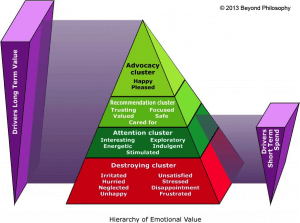The Airline industry is an industry that needs a little help being joyful that no amount of holiday music or cookies can help. Generally, most people don’t associate the airport or a flight during the holidays with joy. But some airlines are having a little fun with their customer experience, which is excellent for creating an emotional bond with their passengers. It’s not often I praise the airline industry but at this festive time of the year I would like to say well done!
WestJet Airlines, an airline founded in 1996 by Clive Beddoe and his business partners, brought some special joy to their customers one day with their video called Real Time Giving. See it for yourself:
This is a fun video that really demonstrates what an organization can do to inject a little joy into their customer’s lives. After watching the video, ask yourself if you aren’t associating WestJet with a fun, joyful company. Do you feel happy and pleased? This is an example of using emotions to create an experience with your customers, or emotional engagement.
Emotions drive everything we do. Every company has what we call at Beyond Philosophy an Emotional Signature, which is way of outlining the level of emotional engagement an organization has with its customers. The emotions of an experience can be instrumental in defining which ones customer associates with your organization. The customers in this experience will always remember and associate joy with the customers. Since this can’t have been a cheap stunt for WestJet, I am sure they are hoping that some of their potential customers will as well.
If WestJet is joy, then this safety video from Delta is cute and funny. They have had some fun with their regular safety video this year. Note all the cameo appearances of pop culture characters from holiday books, films and folklore that make cameos in what is usually a dull video largely ignored by passengers before flights:
Virgin Airlines has a different take on their safety video. No holiday theme here, but the video invokes plenty of fun and happy emotional engagement:
I find myself doing a little chair dance when I watch this. Of course, it’s better to do this dance in my office chair than the tiny seat that I stuff myself into on most flights. But then again if I was chair dancing while I watch this video on a flight with Virgin, I might forget for a minute or two that the chair is so tiny. So score one for Virgin with that little maneuver.
The truth is that the emotions of your customer experience are critical. Too many organizations, most of them in fact, are focused on the other parts of the experience, the ones they can measure and assign an ROI too, like response times and shipping speeds. But the truth is that these “measureable” parts of the experience only make up about half of the whole thing.
According to our research, over 50% of the customer experience is about how a customer feels, which we sometimes refer to as the irrational side of the experience. That means that if your organization is only focusing on improving the measureable parts of your customer experience that are non-emotional (what we call the rational parts of the experience) then you have an incomplete approach to improving your customer experience design. We need to look at the customer journey form an emotional perspective; we call Moment Mapping. You need to look at how a customer feels when they enter your experience so that you can design a deliberate emotional counteraction that will create a better experience for them.
Also, you need to remember when a customer experience starts. Your customer experience starts way before your customers enter your store or go to your website or any other touch point you have with them along the experience. Sometimes it starts when they decide they need something at home when they open the cupboard. Sometimes it starts when their car breaks down on a deserted highway 5 miles from civilization. Other times it starts when they see your clever and joyful YouTube video.
What these airlines are doing is affecting their emotional signature with Customers. Our regular readers will know there are 20 emotions that destroy and drive value for the customer. By putting a name on which ones an organization should look to encourage and which ones to avoid, we essentially are helping an organization address the irrational and emotional side of a customer experience. We have an excellent graphic that illustrates it called “The Hierarchy of Emotional Value.”
As you can see, Happy and Pleased are at the top of the pyramid, meaning they drive the most value. Each of these videos is a shows us an effort by the airlines to create an environment for happy and pleased customers.
So when it comes to your emotional engagement, it’s time to think like an airline this year. What ways can you create ‘Happy’ and ‘Pleased’ customers at some point in your experience? What can you do to inject joy into your customer’s day?
| Colin Shaw is founder & CEO of Beyond Philosophy, one of the world’s first organizations devoted to customer experience. Colin has been recognized by LinkedIn as one of the top 150 Business Influencers in the world. He is an international author of four best-selling books on Customer Experience. Colin’s company, Beyond Philosophy provide consulting, specialised research & training from our Global Headquarters in Tampa, Florida, USA. Follow Colin Shaw on Twitter: @ColinShaw_CX |



